Release 2 (8.1.6)
Part Number A76934-01
Library |
Product |
Contents |
Index |
| Oracle8i Parallel Server Setup and Configuration Guide Release 2 (8.1.6) Part Number A76934-01 |
|
This chapter describes how to install Oracle Parallel Server software and how to create an Oracle Parallel Server database.
Specific topics discussed are:
The type of installation and the type of database you choose to install determines how you proceed with installation and configuration decisions.
When you run Oracle Universal Installer, you can choose to install Oracle8i Enterprise Edition and Oracle Parallel Server with the following installation types:
|
See Also:
"Using Oracle Database Configuration Assistant" for further information about database creation with Oracle Database Configuration Assistant |
During installation, software components are installed on the node from which Oracle Universal Installer is run and pushed to the selected nodes in the cluster.
To install Oracle8i Enterprise Edition and Oracle Parallel Server:
See Also:
Oracle Universal Installer does not make Oracle Parallel Server visible unless Cluster Manager clusterware was properly configured. See your OSD vendor documentation for further information.
The node on which you are running the installation is selected whether or not you select it.
If the list of nodes does not include nodes you expect, the vendor-supplied clusterware is either not installed, not running, or not properly configured.
If clusterware is not installed, click Previous, install Cluster Manager (CM) on these nodes, then click Next. The nodes should now be listed.
op.us.acme.com, and accept or change the common prefix that is to be used for the Oracle System Identifier (SID) for each instance.
Each instance has a SID that is comprised of the common prefix entered here and a thread ID that is automatically generated. For example, if op is entered, the first instance in the cluster is given a SID of op1, and the second instance is given a SID of op2.
During installation no message appears to indicate components are installed to the other nodes.
If you chose a Typical installation type, Net8 Configuration Assistant and Oracle Database Configuration Assistant run after software installation with no user input. Oracle Database Configuration Assistant creates a starter database and adds necessary information to the network configuration. During database creation, Oracle Database Configuration Assistant verifies that the raw devices were created for each tablespace. Raw devices should have been configured in "Setting Up Raw Devices". If the raw devices are not set up properly, Oracle Database Configuration Assistant fails to create the database.
Oracle Universal Installer prompts you with a choice to create a database by using one of the following methods:
This section includes the following topics:
Net8 Configuration and Oracle Database Configuration Assistant (depending on your choice) run after software installation
Net8 Configuration Assistant prompts with the following page:
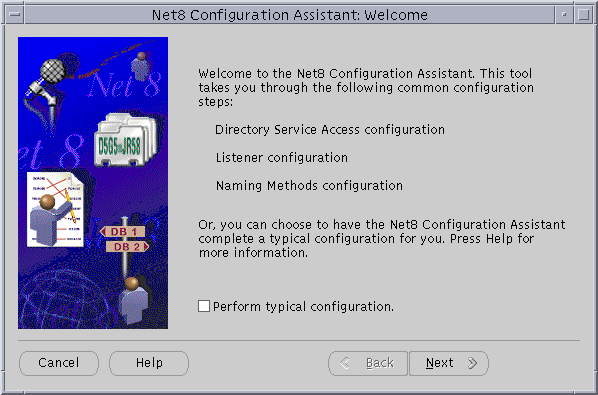
Select "Perform typical configuration" to create the network configuration as a Typical installation. Otherwise, follow the prompts to configure directory service access, listener configuration, and naming method configuration.
|
Note: When configuring the listener, Oracle recommends using the TCP/IP protocol on port 1521. TCP/IP is required for Oracle Enterprise Manager.
If you do not use the registered port of 1521, the LOCAL_LISTENER parameter must be set in the
For further information about configuring non-default port numbers in the |
If you choose to create a database using Oracle Database Configuration Assistant during installation, the following page of the wizard appears:
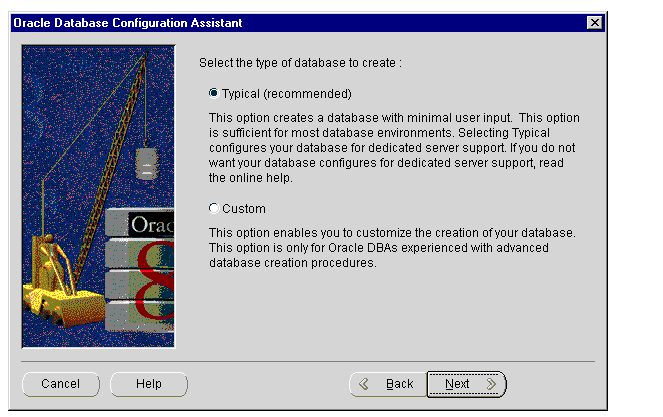
Choose the Typical or Custom database creation type to create a database.
Oracle Database Configuration Assistant creates a database and adds necessary information to the network configuration. If directory access was configured with Net8 Configuration Assistant, an entry for the database service is added to the directory. Clients, also configured with directory access, can access the network information for the database service and connect to the database without a tnsnames.ora file.
|
See Also:
Chapter 2, "Net8 Concepts," in the Net8 Administrator's Guide for further information about LDAP-compliant directory support |
During database creation, Oracle Database Configuration Assistant verifies that the raw devices were created for each tablespace. Raw devices should have been configured in "Setting Up Raw Devices". If the raw devices are not set up properly, Oracle Database Configuration Assistant fails to create the database.
Together, Net8 Configuration Assistant and Oracle Database Configuration Assistant meet all the requirements for proper database creation and Oracle Enterprise Manager discovery of an Oracle Parallel Server. The following sections describe the configured environment in detail:
Oracle Database Configuration Assistant creates necessary Oracle Parallel Server files, following the Optimal Flexible Architecture (OFA) guidelines, whereby database files and administrative files, including initialization parameter files, follow standard naming and placement practices.
The following sections describe operating-system specific configuration issues:
An entry for the Oracle Parallel Server database is created in the oratab file. Oracle Enterprise Manager uses this file during service discovery to determine if the database is an Oracle Parallel Server and the database name.
Oracle Parallel Server entry has the following syntax:
db_name:$ORACLE_HOME:N
where db_name is the database name given to your Oracle Parallel Server database, $ORACLE_HOME is the directory path to the database, and N indicates the database should not be started at reboot time. A sample entry follows for a database named op:
OP:/private/system/op:N
A file called db_name.conf is created in $ORACLE_HOME/ops. Oracle Enterprise Manager uses this file during service discovery to determine which instances run on the nodes.
This file contains the following parameters:
A sample entry follows for a database named op:
node_list="1-2" inst_oracle_sid=(op1, op2) lsnr_listener_name="listener"
On Windows NT, the registry lists all Oracle Parallel Servers that run on a node under the subkey HKEY_LOCAL_MACHINE\SOFTWARE\ORACLE\OSD\PM. Under this subkey, each Oracle Parallel Server cluster has its own registry subkey. Oracle Enterprise Manager uses information to discover the Oracle Parallel Server database name, its instances and nodes.
The following Registry Editor graphic shows a subkey for a database named op:
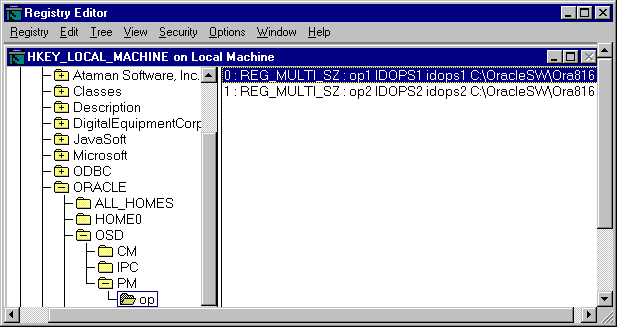
op contains entries for two instances named op1 and op2. The registry values names are node numbers for the instances, starting at 0 for the first node. The second node has a sequential value of 1. These registry values are described in the following table:
Each node is configured with an OracleServicesid service for the instance on that node. It is a Windows NT service that can be controlled from the Control Panel.
This service must be started before the database instance is started.
The instance (System Global Area and background processes) for any Oracle database is started using a parameter file. Each node is configured with an instance-specific initialization parameter file, called initsid.ora, for the instance and a common initialization parameter file, called initdb_name.ora, for an Oracle Parallel Server.
Oracle Database Configuration Assistant creates the initsid.ora and initdb_name.ora files. The file names are based on the global database name and SID information entered in the Database Identification page of Oracle Universal Installer.
|
See Also:
|
This section includes the following topics:
For a Typical installation, Oracle Database Configuration Assistant creates the initsid.ora and initdb_name.ora files in $ORACLE_BASE/admin/db_name/pfile on UNIX and ORACLE_BASE\admin\db_name\pfile on Windows NT for a starter database.
For a Custom installation, the initsid.ora file is created in $ORACLE_BASE/admin/db_name/pfile on UNIX and ORACLE_BASE\admin\db_name\pfile on Windows NT for a starter database. The initdb_name.ora file is also created at this location if the Typical database creation type was chosen. The Custom database creation type enables you to set the initdb_name.ora file location.
For a Typical installation, the initdb_name.ora files is configured with multi-threaded server (MTS).
For a Custom installation, MTS is configured if:
MTS is configured in the following manner:
mts_dispatchers="(protocol=tcp)(listener=listeners_db_name)"
This configuration enables connection load balancing, whereby the number of active connections is balanced among the various instances and MTS dispatchers for the same service. The (listener=listeners_db_name) setting enables an instance to register its instance load information with remote listeners on the other nodes. listeners_db_name is resolved to listener addresses through a tnsnames.ora file.
|
See Also:
|
If you configured a listener that does not use the default listening address--TCP/IP, port 1521--the LOCAL_LISTENER parameter in the initsid.ora file is automatically configured as follows:
local_listener=listener_sid
where listener_sid is resolved to a listener address through either a tnsnames.ora file on the machine.
If Oracle Database Configuration Assistant detects more than one listener on each of the nodes, it displays a list of the listeners. You can select one the listeners displayed. If you select a non-default listener, the LOCAL_LISTENER parameter is set in the initsid.ora file, as described in "Non-Default Listeners".
Services coordinate their sessions with the help of a listener, a process on the server that receives connection requests on behalf of a client application. Listeners are configured to "listen on" protocol addresses for a database service or non-database service.
Protocol addresses are configured in the listener configuration file, listener.ora, for a database service or a non-database service. Clients, configured with the same addresses, can connect to a service through the listener.
During a Typical install, Net8 Configuration Assistant creates and starts a default listener called LISTENER. The listener is configured with default protocol listening addresses for the database and external procedures.
During a Custom installation, you are prompted to create at least one listener with Net8 Configuration Assistant. The listener is configured to listen on one protocol address you specify, as well as an address for external procedures.
Both installation modes configure service information about the Oracle Parallel Server database and external procedures. An Oracle release 8.1 database service automatically registers its information with the listener, such as its service name, instance name(s), and load information. This feature, called service registration, does not require configuration in the listener.ora file. However, Oracle Enterprise Manager management tools require service configuration in the listener.ora file to discover the database. The database service information includes the global database name of the database and Oracle System Identifier (SID) information of the instance.
After listener creation, the listener is started by Net8 Configuration Assistant.
A sample listener.ora file with an entry for an instance named op1 follows:
listener= (description= (address=(protocol=ipc)(key=extproc))) (address=(protocol=tcp)(host=op1-sun1)(port=1521))) sid_list_listener= (sid_list= (sid_desc= (sid_name=plsextproc) (oracle_home=/orahome81) (program=extproc)(sid_desc= (oracle_home=/orahome81) (sid_name=op1)))
Notice that the second SID_DESC entry for the instance does not use have GLOBAL_DBNAME parameter entry. This entry is typical for a listener.ora file entry for a single-instance database, as shown in the following:
(sid_desc= (global_dbname=sales.us.acme.com) (sid_name=sales) (oracle_home=/u01/app/oracle/8.1.6)))
In Oracle Parallel Server environment, the GLOBAL_DBNAME parameter disables connect-time failover or Transparent Application Failover (TAF), Oracle Corporation strongly recommends that you not add this parameter to the listener.ora file.
If you chose to configure access to a LDAP-compliant directory server with Net8 Configuration Assistant during a Custom installation, a ldap.ora file is created. This file contains the following types of information:
A tnsnames.ora file is created on each node and a centralized directory (if configured during a Custom installation) is configured with net service names. A connect identifier is an identifier that maps to a connect descriptor. A connect descriptor contains the following information:
Net service names are created for the following connections:
| Net Service Name Type | Description |
|---|---|
|
Database connections |
Oracle Enterprise Manager searches for a net service name entry for the database. This entry enables Oracle Enterprise Manager to discover an Oracle Parallel Server database and to determine which instances to use for a connection. A listener protocol address is configured for each instance. In addition, the LOAD_BALANCE and FAILOVER options force the address to be chosen randomly. If the chosen address fails, the connection request is failed over to the next address. This way, if an instance should go down, Oracle Enterprise Manager can still connect by way of another instance.
In the following example, op.us.acme.com= (description= (load_balance=on) Note: FAILOVER=ON in set by default for a list of addresses. Thus, it does not need to be explicitly specified. |
|
Instance connections |
Oracle Enterprise Manager searches for a net service name entry for each instance. This entry enables Oracle Enterprise Manager to discover the instances in the cluster. These entries are also used to start and stop instances.
In the following example, op1.us.acme.com= (description= (address=(protocol=tcp)(host=op1-server)(port=1521)) (connect_data= (service_name=op.us.acme.com) (instance_name=op1))) |
|
Startup instance connections for Windows NT |
If Oracle Parallel Server is installed on Windows NT, additional net service name entries are created with connections to the SID rather than the database service name. These net service names are identified uniquely by On Windows NT, a remote connection is performed from one of the nodes to the other nodes. This remote connection cannot accept the SERVICE_NAME and INSTANCE_NAME parameters if the database is down. Therefore, a remote connection must specify the SID to start in dedicated server mode.
In the following example, op1_startup.us.acme.com= (description= (address=(protocol=tcp)(host=op1-pc)(port= 1521)) (connect_data= (sid=op1) (server=dedicated)) When Oracle Enterprise Manager performs starts an instance on a UNIX node, it passes a command to a process on the node to perform a local connection. Therefore, these entries are not created. |
|
Remote listeners |
As discussed in "Multi-Threaded Server Configuration", the MTS_DISPATCHERS parameter is set in the mts_dispatchers="(protocol=tcp)(listener=listeners_db_name)"
This enables the instance to know about the remote listeners on the other nodes.
In the following example, listeners_op.us.acme.com= The instance uses this list to determine the names of the remote listeners to register its information. |
|
Non-default listeners |
As discussed in "Non-Default Listeners" and "Multiple Listeners", the LOCAL_LISTENER parameter is set in the local_listener=listener_sid
In the sample below,
listener_op1.us.acme.com=
|
|
External procedures |
An entry for connections to external procedures. This enables an Oracle8i database to connect to external procedures. extproc_connection_data.us.acme.com= (description= (address_list= (address=(protocol=ipc)(key=extproc0)) (connect_data= (sid=plsextproc))) |
A sample tnsnames.ora file created during a Typical installation follows:
op.us.acme.com= (description= (load_balance=on) (failover=on) (address_list=(address=(protocol=tcp)(host=op1-sun)(port=1521))(address=(protocol=tcp)(host=op2-sun)(port=1521))) (connect_data= (service_name=op.us.acme.com))) op1.us.acme.com= (description= (address=(protocol=tcp)(host=op1-sun)(port=1521)) (connect_data= (service_name=op.us.acme.com) (instance_name=op1))) op2.us.acme.com= (description= (address=(protocol=tcp)(host=op2-sun)(port=1521)) (connect_data= (service_name=op.us.acme.com) (instance_name=op2))) listeners_op.us.acme.com=(address=(protocol=tcp)(host=op1-sun)(port= 1521))(address=(protocol=tcp)(host=op2-sun)(port=1521)) extproc_connection_data.us.acme.com= (description= (address_list= (address=(protocol=ipc)(key=extproc)) (connect_data= (sid=plsextproc) (presentation=RO)))
The sqlnet.ora file is automatically configured with:
This domain is automatically appended to any unqualified net service name or service name. For example, if the default domain is set to us.acme.com, op in the connect string CONNECT scott/tiger@op gets looked up as op.us.acme.com.
The order of naming methods is as follows: directory naming (for Custom installation only), tnsnames.ora file, Oracle Names server, and host naming.
A sample sqlnet.ora file created during a Typical installation follows:
names.default_domain=us.acme.comnames.directory_path=(tnsnames, onames,hostname)
If Oracle Universal Installer detects an earlier version of an Oracle database on your hard drive, you are prompted to migrate or upgrade the database to release 8.1.
|
Important: Do not click the "Migrate an Existing Database" check box, as Oracle Data Migration Assistant does not support Oracle Parallel Server. Instead, use the Migration utility to migrate after installation, as described in Oracle8i Migration guide. |
|
Note: Migrating or upgrading on Windows NT involves disabling the OraclePGMSService and starting and shutting down the Operating System Dependent layer at a specific point during migration. These instructions are not covered in the Oracle8i Migration guide. See Oracle8i Administrator's Guide for Windows NT for complete migration and upgrade steps. |
As long as your Oracle database software version numbers are greater than 8.1, they can co-exist on the same cluster. This also means you cannot have different versions of Oracle older than release 8.1 on the same cluster. For example, a release 8.0 and a release 8.1 Oracle Parallel Server database are not compatible on the same cluster.
Rolling upgrades--where different databases, or different instances of the same database in Oracle Parallel Server, are upgraded to a new version of Oracle one at a time--are not supported.
Like an Oracle8i Enterprise Edition database, Oracle Parallel Server on UNIX supports multiple Oracle homes, a feature that enables you to install one or more releases on the same machine (in multiple Oracle home directories). Windows NT also supports multiple Oracle homes, but all the Oracle homes must contain the same release of Oracle8i Enterprise Edition and Oracle Parallel Server.
Both UNIX and Windows NT require that each node have only one copy of the vendor-supplied Operating System Dependent layer active.
If you choose not to create a database during installation, you can create a database using Oracle Database Configuration Assistant or manuals methods. Specific topics discussed are:
This section describes using Oracle Database Configuration Assistant in stand-alone mode:
In order to create a database with Oracle Database Configuration Assistant, the raw devices for the tablespaces must be created. During database creation, Oracle Database Configuration Assistant verifies that the raw devices were created for each tablespace. If the raw devices are not set up properly, Oracle Database Configuration Assistant fails to create the database.
To create a database with Oracle Database Configuration Assistant:
dbassist from $ORACLE_HOME/bin.
The welcome page appears:
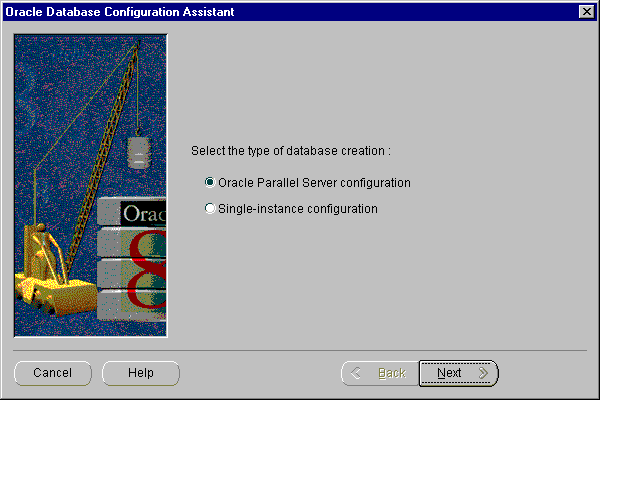
The following page appears:
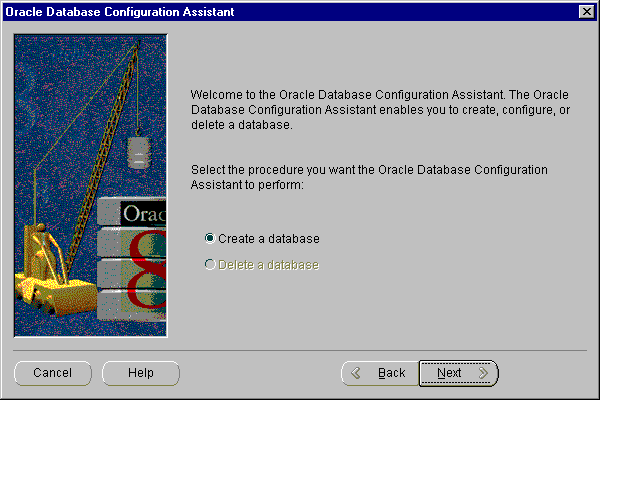
The following error message may appear if there is a problem with the clusterware:
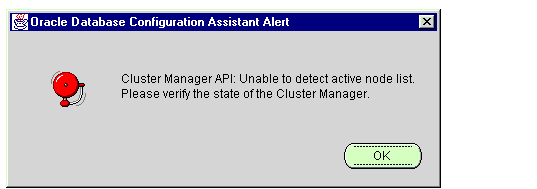
On UNIX, this message indicates that Oracle Database Configuration Assistant is unable to detect the lists of nodes in the cluster. See your Operating System Dependent vendor documentation for further information.
On Windows NT, this messages indicates that Cluster Manager (CM) is installed but one of the following problems were detected:
To resolve this error message:
NET USE \\host_name\C$
where host_name is the host name defined in the DefinedNodes registry value for CM.
A successful connection results in the following message:
The command completed successfully.
Oracle recommends using the same user name and password on each node in a cluster or using a domain user name. If you use a domain user name, log on under a domain with username and password which has administrative privileges on each node.
The following page appears:
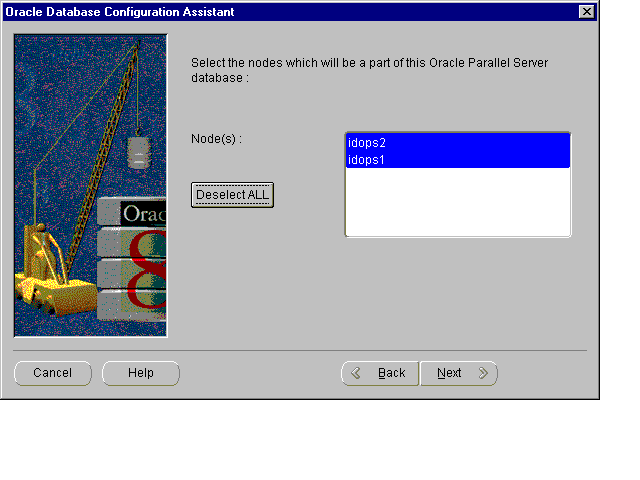
The following page appears:
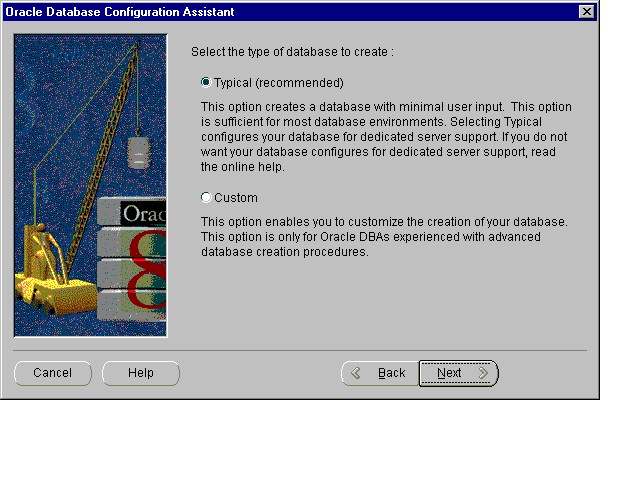
When you get to the page that requests the global database name and SID Prefix:
op.us.acme.com.
The prefix entered here is appended with each node's thread ID to create the SID for instances. For example, if op is entered, the first instance in the cluster is given a SID of op1, and the second instance is given a SID of op2.
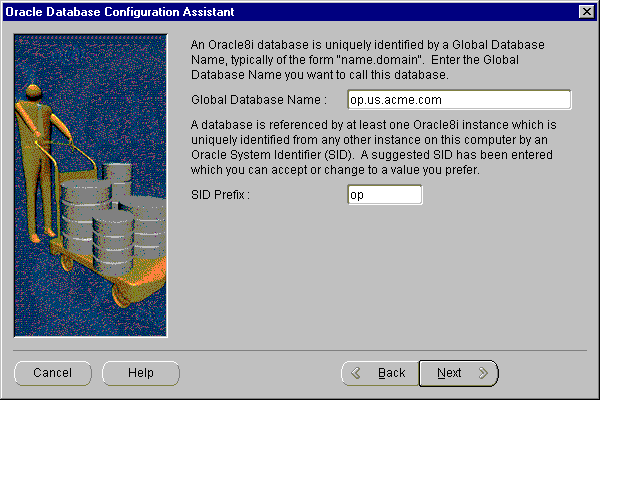
In addition to database creation, Oracle Database Configuration Assistant adds necessary information to the network configuration. If directory access was configured with Net8 Configuration Assistant, an entry for the database service is added to the directory. Clients, also configured with directory access, can access the network information for the database service and connect to the database without a tnsnames.ora file.
|
See Also:
"Understanding the Installed Configuration" to understand how the configuration files are configured |
You might choose to create your database manually if you already have existing scripts, or have different requirements than can be met by using Oracle Database Configuration Assistant.
To create a new database and make it available for system use, perform the following tasks:
Task 1: Specify database and instance settings.
Task 2: Back up any existing databases.
Task 3: Set operating-system specific configuration
Task 4: Set ORACLE_SID for each node.
Task 5: Create initialization parameter files.
Task 6: Create the password files.
Task 7: Prepare a CREATE DATABASE OPS script.
Task 10: Configure Net8 on nodes.
In order to understand the database creation process, you may want to review all the steps before performing the tasks.
In Oracle Parallel Server, each node has its own instance. The instances together form an Oracle Parallel Server database. Being aware of database- and instance-level information enables you to more easily complete Task 2 through Task 12.
To determine database and instance-level information:
op:
| Database Name | Database Domain | Global Database Name | SID Prefix |
|---|---|---|---|
|
|
|
|
|
| Component | Description |
|---|---|
|
Node name |
The node name defined by the Cluster Manager software
Use the command
|
|
Node number |
The number associated with the node.
Use the command On Windows NT, the first nodes always has a node number of 0. Other nodes should have sequential values, such as 1 for the second node, and 2 for the third node, and so on. |
|
Host name |
The host name of the computer. The host name may be the same names as the node name.
On UNIX and Windows NT, use the command |
|
Oracle Home |
The directory path location where Oracle Universal Installer installed the software, including binaries |
|
|
The directory path location set up by Oracle Universal Installer. The Oracle Base contains the Oracle Home. It can also be used to store administrative files, including initialization parameter files and database trace files.
Oracle Corporation recommends using the OFA directory structure used by the Oracle Database Configuration Assistant, which places administrative files under a directory called See Also: "Understanding the Oracle Parallel Server Directory Structure" |
|
Thread ID |
Each node requires a unique thread ID. The thread ID is appended to the SID prefix to create the SID for the instance on the node. |
idops1 and idops2:
| Node Name | Node Number | Host Name | Oracle Base | Oracle Home | Thread ID | SID |
|---|---|---|---|---|---|---|
|
|
|
|
|
|
|
|
|
|
|
|
|
|
|
|
Oracle strongly recommends that you make complete backups of all existing databases before creating a new database, in case database creation accidentally affects some existing files. Backup should include parameter files, database files, redo log files, and control files.
The following sections describe the operating-system specific configuration:
If you plan to use Oracle Enterprise Manager, manually create an entry in oratab file on each node. This file identifies the Oracle Parallel Server database. Oracle Enterprise Manager uses this file during service discovery to determine if the database is an Oracle Parallel Server and its database name.
The oratab file is stored in /etc/oratab or /var/opt/oracle/oratab, depending on your operating system.
The syntax for this entry is:
db_name:$ORACLE_HOME:N
db_name is the database name given to your Oracle Parallel Server database, $ORACLE_HOME is the directory path to the database, and N indicates the database should not be started at reboot time. Use the database name and Oracle home you specified in Task 1: Specify database and instance settings.
A sample entry follows for a database named op:
OP:/private/system/op:N
If you plan to use Oracle Enterprise Manager, manually create the db_name.conf file on each node. Ensure that it contains the node_list, inst_oracle_sid, and lsnr_listener_name parameters. Oracle Enterprise Manager searches for these entries to discover what instance and listener run on each node. The db_name.conf file must be stored in $ORACLE_HOME/ops. If the /ops directory does not exist, create it.
Sample contents follow for a two-node cluster:
node_list="0,1" inst_oracle_sid=(op1, op2) lsnr_listener_name="listener"Any value can be used for the
lsnr_listener_name parameter. Use the node
number for the node_list parameter and the SID value for the inst_oracle_
sid parameter you specified in Task 1: Specify database and instance settings.
If you plan to use Oracle Enterprise Manager, create a \PM\db_name key in HKEY_LOCAL_MACHINE\SOFTWARE\ORACLE\OSD for the Oracle Parallel Server database. Oracle Enterprise Manager uses this key to discover the Oracle Parallel Server database name, its instances and nodes.
The PM and db_name keys should have a class type of REG_SZ.
The db_name key must contain registry values for each instance in the cluster. The registry values names are node numbers for the instances, starting at 0 for the first node, regardless of the node's thread ID. Other nodes should have sequential values, such as 1 for the second node, and 2 for the third node, and so on.
When creating the registry values, the data type must be REG_MULTI_SZ. In the Multi-String Editor dialog box, enter the following on separate lines:
Use the information you entered in Task 1: Specify database and instance settings.
The following Registry Editor graphic shows a subkey of op with values entered for instance op1:
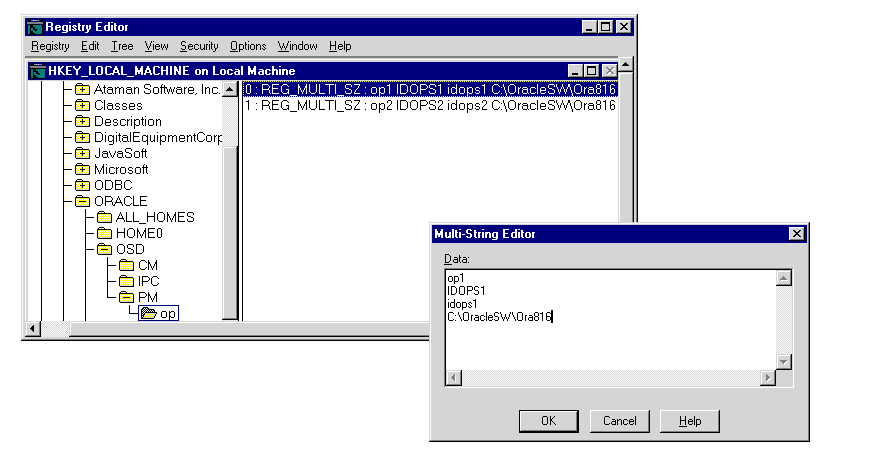
op contains two registry values for two instances, as described in the following table:
The SID must be defined for each node in the cluster. For simplicity, Oracle recommends SIDs that consist of the database name as the common base and the thread ID of the node you specified in Task 1: Specify database and instance settings. For example, if op is the database name, the first instance in the cluster is given a SID of op1, and the second instance is given a SID of op2. SID specification is operating-system specific:
On UNIX, the ORACLE_SID environment variable must be set.
On Windows NT, the ORACLE_SID registry value must be set in HKEY_LOCAL_MACHINE\SOFTWARE\ORACLE\HOMEID.
Once the SIDs are created, create an OracleServicesid service. You can use this service to start or stop an instance from the Control Panel. To create OracleServicesid:
crtsrv batch file to create a unique service corresponding to the instance of the node.
C:\ORACLE_HOME\bin> crtsrv sid
For example, to create a service for a SID of op1, OracleServiceop1, enter the following:
C:\ORACLE_HOME\bin> crtsrv op1
The Services window appears:
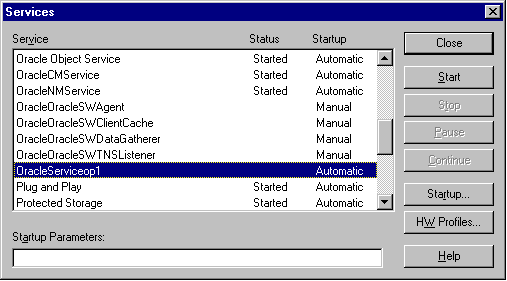
The instance (System Global Area and background processes) for any Oracle database is started using a parameter file. For each node, Oracle recommends creating an instance-specific initialization parameter file, named initsid.ora, for the instance parameters and a common initialization parameter file, named initdb_name.ora, for the Oracle Parallel Server parameters.
To create a parameter file for the database you are about to make, make a copy of the initialization parameter files located in $ORACLE_HOME/opsm/admin on UNIX or ORACLE_HOME\opsm\admin on Windows NT. Give these files new file names. You can then edit and customize these new files for the new database.
To create a new database, inspect and edit the following parameters of the new initsid.ora parameter file:
Inspect and edit the following parameters of the new initdb_name.ora parameter file:
"Understanding the Initialization Parameter Files" for further information about initialization parameter files and parameters to use
See Also:
Use the Password Utility ORAPWD to create password files. ORAPWD is automatically installed with the Oracle8i Utilities. Password files are located in the $ORACLE_HOME/dbs on UNIX and ORACLE_HOME\database directory on Windows NT. They are named orapwsid on UNIX and pwdsid.ora on Windows NT, where sid identifies the database name you specified in Task 1: Specify database and instance settings.
To create a password file on each of the nodes:
orapwd from $ORACLE_HOME/bin with the following syntax:
ORAPWD file=$ORACLE_HOME/dbs/orapwsid password=password
orapwd from ORACLE_HOME/bin with the following syntax:
ORAPWD file=ORACLE_HOME\database\pwdsid.ora password=password
FILE specifies the password file name and PASSWORD sets the password for the INTERNAL and SYS accounts.
Prepare a CREATE DATABASE OPS script on one of the nodes by using the ops.sql sample script, located in $ORACLE_HOME/opsm/admin on UNIX or ORACLE_HOME\opsm\admin on Windows NT. The sample script is for a two-node cluster. If you use the sample script, inspect and edit the following:
initdb_name.ora file.
oracle in the CONNECT INTERNAL\oracle line to reflect the password you created in Task 6: Create the password files.
$ORACLE_HOME/rdbms/admin on UNIX and ORACLE_HOME\rdms/admin on Windows NT, to reflect the Oracle home you specified in Task 1: Specify database and instance settings.
To create the new database, run the SQL CREATE DATABASE OPS script:
=SQL> @path/ops.sql;
When you execute this script, Oracle performs the following operations:
You should make a full backup of the database to ensure that you have a complete set of files from which to recover if a media failure occurs.
The listener.ora file, sqlnet.ora file and tnsnames.ora files must be configured properly, as described in the following table:
| Configuration File | Description | Configuration Requirements |
|---|---|---|
|
|
Includes addresses of all network listeners on a server, the SIDs of the databases for which they listen, and various control parameters used by the listener |
The
See Also:
|
|
|
Includes a list of network descriptions of service names, called net service names
|
See Also:
|
|
|
Includes the names resolution method |
Because the net service names are specified in See Also: "Profile (sqlnet.ora file)" for a sample configuration |
To start the Oracle Parallel Server database in parallel mode:
LSNRCTLLSNRCTL>start[listener_name]
where listener_name is the name of the listener defined in the listener.ora file. It is not necessary to identify the listener if you are using the default listener named LISTENER.
LSNRCTL displays a status message indicating that the listener has started successfully. Check that all expected services for that listener are listed in the services summary in the status message.
SQL> CONNECT internal/password
SQL> STARTUP;
The first instance to start up in shared mode determines the values of the global cache parameters for the other instances. The control file records the values of the GC_* parameters when the first instance starts up.
When another instance attempts to start up in shared mode, the Oracle Parallel Server compares the values of the global constant parameters in its parameter file with those already in use and issues a message if any values are incompatible. The instance cannot mount the database unless it has the correct values for its global constant parameters.
SQL> CONNECT internal/password
SQL> STARTUP;
To verify instances are running:
SQL> CONNECT internal/password
SQL> SELECT * from v$active_instances;
Output similar to the following is returned.
INST_NUMBER INST_NAME ----------- ----------------- 1 op1-sun:op1 2 op2-sun:op2 3 op3-sun:op3
| Column | Description |
|---|---|
|
INSTANCE_NUMBER |
Identifies the instance number. |
|
INST_NAME |
Identifies the host name and instance name. |
SQL> CONNECT scott/tiger
SQL> SELECT * from emp;
The employee table displays:
EMPNO ENAME JOB MGR HIREDATE SAL COMM DEPTNO --------- ---------- --------- --------- --------- --------- --------- --------- 7369 SMITH CLERK 7902 17-DEC-80 800 20 7499 ALLEN SALESMAN 7698 20-FEB-81 1600 300 30 7521 WARD SALESMAN 7698 22-FEB-81 1250 500 30 7566 JONES MANAGER 7839 02-APR-81 2975 20 7654 MARTIN SALESMAN 7698 28-SEP-81 1250 1400 30 7698 BLAKE MANAGER 7839 01-MAY-81 2850 30 7782 CLARK MANAGER 7839 09-JUN-81 2450 10 7788 SCOTT ANALYST 7566 19-APR-87 3000 20 7839 KING PRESIDENT 17-NOV-81 5000 10 7844 TURNER SALESMAN 7698 08-SEP-81 1500 0 30 7876 ADAMS CLERK 7788 23-MAY-87 1100 20 7900 JAMES CLERK 7698 03-DEC-81 950 30 7902 FORD ANALYST 7566 03-DEC-81 3000 20 7934 MILLER CLERK 7782 23-JAN-82 1300 1014 rows selected.
The Delete a Database option of Oracle Database Configuration Assistant lets you quickly and easily delete a database. Deleting a database removes its initialization parameter files, instances, OFA structure, and operating system configuration. Data files are not removed from the raw partitions.
To delete a database with Oracle Database Configuration Assistant.
dbassist from $ORACLE_HOME/bin.
The welcome page appears:

The following page appears:
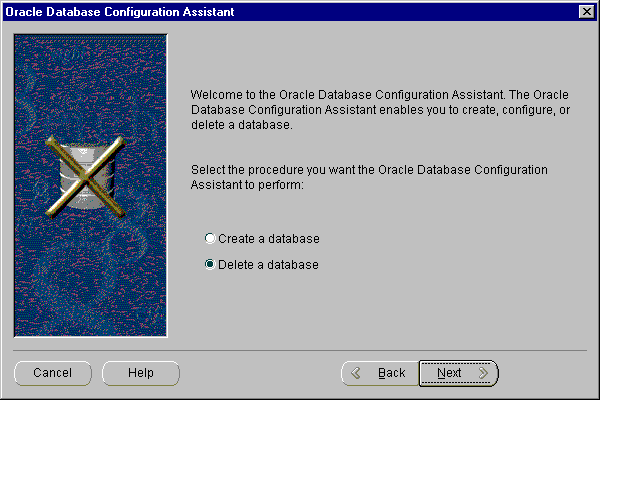
The following page appears. It displays the Oracle Parallel Server databases detected.
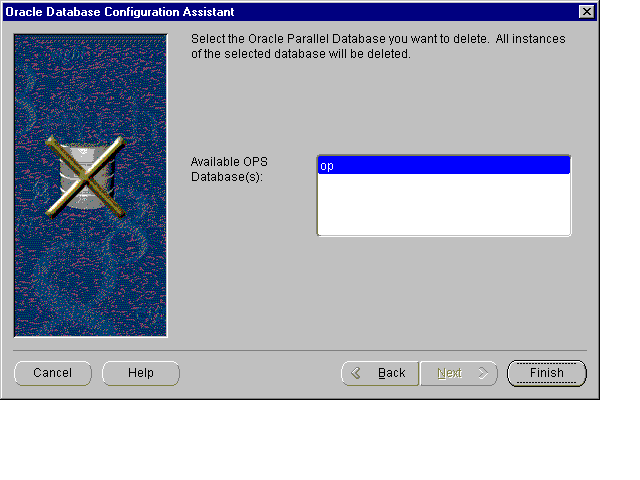
The following alert dialog box appears:

|
|
 Copyright © 1996-2000, Oracle Corporation. All Rights Reserved. |
|